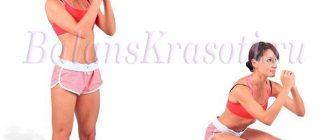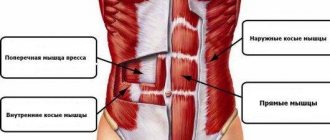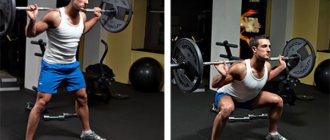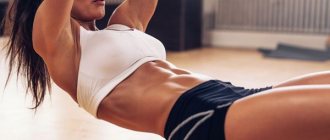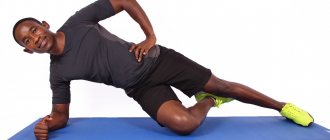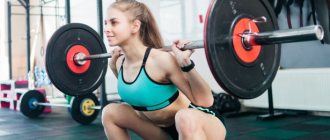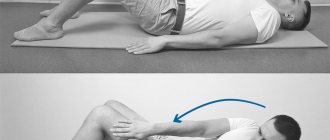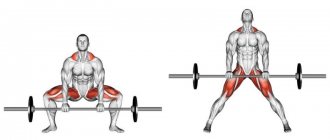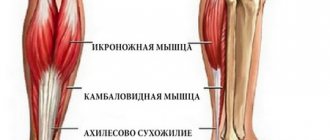The squat is a basic exercise that creates the best conditions for achieving many goals, be it maintaining physical condition, enlarging the hips and gluteal muscles, or losing weight.
The developed squat program will allow you to achieve the desired results and improve your health. An important advantage of the training complex is the ability to carry it out not only in the gym with various weights, but also at home.
Why do 100 squats every day?
It is believed that in order to grow muscles, it is necessary to perform strength exercises with heavy equipment. But most lovers of a healthy lifestyle do not need bulky muscles. Their goal is a toned, slender body with minimal fat. For such athletes, we recommend doing 100 squats a day. For beginners, the exercise should be performed with your own body weight.
Let's consider the positive effect of such training:
- Fat burning . At first glance, it seems that 100 repetitions per day is not enough for weight loss. In fact, after 50–60 squats, the athlete experiences the same load as a twenty-minute jog at an easy pace, while burning 120–150 kcal.
- Getting rid of cellulite . Flabby buttocks and thighs are one of the main women's problems. A set of squats performed every day improves blood supply to the subcutaneous layer, which helps cope with cellulite.
- Correction of the shape of the hips and buttocks . Of course, you won’t be able to build muscle in your lower body. But through regular exercise, the athlete increases blood circulation, which helps maintain toned legs and buttocks.
- Posture correction . The technique of classic squats involves maintaining a flat back with a slight arch in the lower back. Thanks to this, the muscles and tissues around the spine are strengthened. As a result, the stoop disappears and a beautiful gait appears.
- Increased endurance . During daily training, not only muscles are strengthened, but also ligaments and tendons. This allows for more productive cardio training, which improves weight loss results.
All positive aspects are noticeable only with regular exercise. You can't skip workouts. Even if you feel tired or sore in your muscles, you still need to do 100 squats. This is how the athlete maintains muscle tone, maintains metabolic processes at a high level and forms the habit of daily physical activity.
Training with your own body weight does not increase strength, but many girls have noticed that after 15-17 days of regular squats they feel lighter and can do more repetitions. In this case, it is recommended to add weights to your training plan. Light dumbbells from 2 to 5 kg or a special weight belt are suitable for this.
Sample programs
The squat pattern is of great importance to obtain the desired results. It allows you to create and control the progression of the load by increasing the number of repetitions, approaches, weight of weights and is suitable for beginner athletes. She will help girls change their body shape, work on the beauty of their legs and buttocks, improve their endurance, and remove excess weight from problem areas.
Men need it to gain muscle mass and strength. At the same time, the program aimed at increasing the number of muscles and strength differs from the one that girls should work on. Squats for weight loss are aimed at gradually increasing the number of repetitions in the approach.
Squat chart for 30 days for girls
The 30-day squat table for girls assumes a regular increase in load. The program is aimed at losing weight and increasing endurance.
You should start with a small amount. Weekends are provided for muscle recovery.
If you have training experience and the loads seem easy, you should start with 80% of the repetitions of the maximum and increase them in proportion to the table. With small daily workouts you can achieve big results. Gradual adaptation of muscles to new loads will allow you to get a significant effect over time. At the end of the cycle, it is advisable to perform the exercise in several approaches.
Squats for the buttocks, the monthly program of which is given in the table, are performed according to the following scheme.
| Program | |
| Day | Number of repetitions |
| 1 | 20 times |
| 2 | 25 times |
| 3 | rest |
| 4 | 30 times |
| 5 | 35 times |
| 6 | rest |
| 7 | 40 times |
| 8 | 45 times |
| 9 | rest |
| 10 | 50 times |
| 11 | 55 times |
| 12 | rest |
| 13 | 60 times |
| 14 | 65 times |
| 15 | rest |
| 16 | 70 times |
| 17 | 72 times |
| 18 | rest |
| 19 | 75 times |
| 20 | 77 times |
| 21 | rest |
| 22 | 80 times |
| 23 | 82 times |
| 24 | rest |
| 25 | 85 times |
| 26 | 88 times |
| 27 | rest |
| 28 | 90 times |
| 29 | rest |
| 30 | 100 times |
Squat program for men
A set of squats can be built both for home and for the gym. First, you should work on your muscle endurance.
| Monthly program for men | |
| Day | Number of repetitions |
| 1 | 30 times |
| 2 | 35 times |
| 3 | rest |
| 4 | 40 times |
| 5 | 45 times |
| 6 | rest |
| 7 | 50 times |
| 8 | 55 times |
| 9 | rest |
| 10 | 60 times |
| 11 | 65 times |
| 12 | rest |
| 13 | 70 times |
| 14 | 75 times |
| 15 | rest |
| 16 | 80 times |
| 17 | 85 times |
| 18 | rest |
| 19 | 90 times |
| 20 | 95 times |
| 21 | rest |
| 22 | 100 times |
| 23 | 105 times |
| 24 | rest |
| 25 | 110 times |
| 26 | 115 times |
| 27 | rest |
| 28 | 120 times |
| 29 | 125 times |
| 30 | rest |
There is no point in increasing the number of squats in the future. You need to do the exercise in several approaches and start using additional weight.
If the goal is to increase muscle mass, an example of a training plan is as follows.
| Program to increase muscle mass | |||
| Day | Weight, kg | Number of approaches | Number of repetitions |
| 1 | 20 | 3 | 6-12 |
| 2 | – | – | – |
| 3 | – | 3 | 15-20 |
| 4 | – | – | – |
| 5 | – | – | – |
| 6 | – | – | – |
| 7 | 25 | 3 | 6-12 |
| 8 | – | – | – |
| 9 | – | – | – |
| 10 | – | 3 | 15-20 |
| 11 | – | – | |
| 12 | – | – | – |
| 13 | – | – | – |
| 14 | 30 | 3 | 6-12 |
| 15 | – | – | – |
| 16 | – | – | – |
| 17 | – | 3 | 15-20 |
| 18 | – | – | – |
| 19 | – | – | – |
| 20 | 35 | 3 | 6-12 |
| 21 | – | – | – |
| 22 | – | – | – |
| 23 | – | 3 | 15-20 |
| 24 | – | – | – |
| 25 | – | – | – |
| 26 | 40 | 3 | 6-12 |
| 27 | – | – | |
| 28 | – | – | – |
| 29 | – | – | – |
| 30 | 10 | 3 | 15-20 |
In this program, progress is to increase working weights. An important condition for muscle recovery and growth is alternating light and heavy training.
What kind of squats should I do?
Beginning athletes are faced with the problem of selecting exercises from a variety of squat options. We recommend starting with the classic ones - feet shoulder-width apart, back straight, pelvis lowered to a right angle at the knees or slightly lower. This technique allows you to use the quadriceps and buttocks - muscle groups responsible for the formation of beautiful legs.
To fully work out your lower body, you should combine different types of squats. For example, girls very often have the problem of sagging inner thighs. An effective exercise in this case would be a plie squat - the feet stand very wide, the toes are turned outward, the pelvis is lowered to a right angle at the knees. The element allows you to work the adductor muscles of the thigh.
There are also squats for the buttocks - curtsy. Briefly about the technique: the athlete takes a wide step back and places his toe on the floor; the foot of the abducted limb should be behind the line of the supporting leg; From this position, smooth squats are performed. The element specifically loads the gluteal muscles. To enhance the effect, we recommend using light dumbbells or weights.
Types of squats
There are many varieties of squats, both with your own body weight and with additional weights.
Among those that are suitable for home training and do not require special skills, we highlight the following:
- Classic squats (technique described above)
- Deep squats
The same classic squats, but with a greater range of motion - much lower than parallel.
This technique is more energy-intensive, meaning it burns more calories. It also helps to engage the hamstrings and gluteal muscles more strongly.
In addition to the obvious advantages, deep squats also have disadvantages. The main one is related to the technique of execution. Here it is more problematic to keep your back straight in the lower phase of the movement.
The second disadvantage is that this option may not be suitable for men with serious spinal problems.
- Sumo
Here the feet are placed wider than the shoulders (wide stance). The range of movement is up to the parallel of the thighs with the floor. This feature of the execution technique redirects the load on the inner thighs and gluteals.
You can choose any of the options given above, but in terms of effectiveness and safety, the most suitable would be classic squats to parallel with the floor.
Squat technique and mistakes
Beginners believe that exercises without power equipment are undemanding in terms of quality of execution. This is wrong. If you do not pay attention to mistakes, you can negate the benefits of the element and harm the body.
Let's look at the technique of classic squats:
- Let's get straight.
- We spread our feet shoulder-width apart, with our toes slightly turned to the sides.
- Inhale and smoothly lower the pelvis to a right angle at the knee joints.
- At the same time, bend your arms and bring your palms together at chest level.
- Exhale and rise to the starting position.
At first glance, the technique is simple. But you should take into account the nuances that affect the effectiveness of the exercise:
- Keep your head straight. When the chin drops, an involuntary rounding of the upper back occurs.
- We don’t “throw” our body down, we sit down smoothly. Excluding the negative phase of the squat reduces its overall effectiveness.
- Don't lean forward too much. The basis of the movement should be abduction of the pelvic region back and bending of the legs.
- Keep the center of gravity in the middle of the feet. When you shift onto your toes, the dangerous load on your knees increases.
When performing squats, maintain a bend in your lower back. Back position is very important. If you “round” the spine, the effect of stretching the gluteal muscles is lost, and the load shifts to the front of the thigh. Watch your back position throughout the entire approach.
First week of training
- If you squatted 10 times or less in the initial test, select a training plan from the first column
- If you squatted from 11 to 20 times, the second column is yours
- From 21 to 30 times in a row? Cool! Third column!
- More than 30? Don't be a fool, third week and third column!
Table 2. First week of training.
If you passed the first week without any difficulties, great, let's move on to the second. If it was hard for you, repeat the first week.
Monthly training plan for girls
The 30-day squat program is designed to provide a comprehensive lower body workout. The plan includes 3 exercises that allow you to effectively train the muscles of your thighs and buttocks. Due to the fact that the complex simultaneously engages large muscles, calorie consumption increases, and this has a positive effect on weight loss.
Squat Chart:
| Day | Classic squats | Plie | Curtsy | Total |
| 1 | 14 | 15 | 15 | 44 |
| 2 | 16 | 16 | 16 | 48 |
| 3 | 18 | 17 | 17 | 52 |
| 4 | 20 | 18 | 18 | 56 |
| 5 | 22 | 19 | 19 | 60 |
| 6 | 24 | 20 | 20 | 64 |
| 7 | 26 | 21 | 21 | 68 |
| 8 | 28 | 22 | 22 | 72 |
| 9 | 30 | 23 | 23 | 76 |
| 10 | 32 | 24 | 24 | 80 |
| 11 | 34 | 25 | 25 | 84 |
| 12 | 36 | 26 | 26 | 88 |
| 13 | 38 | 27 | 27 | 92 |
| 14 | 40 | 28 | 28 | 96 |
| 15 | 42 | 29 | 29 | 100 |
| 16 | 44 | 30 | 30 | 104 |
| 17 | 46 | 31 | 31 | 108 |
| 18 | 48 | 32 | 32 | 112 |
| 19 | 50 | 33 | 33 | 116 |
| 20 | 52 | 34 | 34 | 120 |
| 21 | 54 | 35 | 35 | 124 |
| 22 | 56 | 36 | 36 | 128 |
| 23 | 58 | 37 | 37 | 132 |
| 24 | 60 | 38 | 38 | 136 |
| 25 | 62 | 39 | 39 | 140 |
| 26 | 64 | 40 | 40 | 144 |
| 27 | 66 | 41 | 41 | 148 |
| 28 | 68 | 42 | 42 | 152 |
| 29 | 70 | 43 | 43 | 156 |
| 30 | 72 | 44 | 44 | 160 |
Rest between exercises is 45–60 seconds. Try to keep your breaks short. Do your workout at an average pace.
Make sure that the lowering of the body is equal in time to the rising. The plan is suitable for those who find the “100 reps per day” scheme difficult.
How to squat correctly: useful tips
The 30-day squat program for girls, the table of which is presented above, will be effective if the technique of performing the exercise is correct. Follow these recommendations:
- Before you start squatting, warm up your muscles. When warming up, pay special attention to your ankle. Proper warm-up can reduce the risk of injury and prevent severe muscle pain.
- In the starting position, you should stand straight, your back should be straight. Place your feet shoulder-width apart, point your toes slightly to the sides, and extend your arms forward. Your legs should be bent at the knees until your thighs are parallel to the floor.
- First, do squats without weights. When you are more prepared, you can use weights, dumbbells, or a barbell.
- When doing squats for 30 days, don't rush. Do the exercise smoothly and slowly - this will help work out the muscles as much as possible. You should feel their tension.
- Proper breathing technique is important. Breathe smoothly and calmly. The main effort is always made on exhalation. When squatting, do not lift your heels off the floor.
- You can break the number of squats into four or more sets. The optimal duration of the break between them is 5-10 minutes.
- A 30-day squat chart will help improve motivation and focus. It is better to print it out and place it in a visible place. This will help you not to quit halfway to success.
With overwhelmingly positive reviews, the 30-Day Squat Program is a simple and effective way to get into the shape you want. If you want to lose weight, supplement them with diet and cardio exercises , if you just want to pump up your muscles - with other strength exercises to work them out. If you have achieved the desired results, you should not stop exercising, but you can reduce the frequency of exercise by just staying in shape.
Program “200 squats”
It is difficult for beginner athletes to train without recovery breaks. With this regimen, they experience constant fatigue and muscle pain. Daily physical activity causes lethargy, low mood and decreased motivation are often observed.
The listed symptoms indicate the development of overtraining. This condition causes progress in sports to stop.
To avoid the adverse consequences of daily training, it is necessary to structure the program in such a way that a “window” appears between classes - at least 24 hours. During this period, the body will restore damaged muscle fibers and burn subcutaneous fat.
Below is a plan that is designed for 3 workouts per week. In a month, the athlete will be able to perform 200 squats per session.
Week #1
| Day | Set 1 | Set 2 | Set 3 | Set 4 | Set 5 | Total |
| Monday | 13 | 6 | 9 | 9 | 13 | 50 |
| Wednesday | 13 | 16 | 13 | 16 | 16 | 74 |
| Friday | 15 | 20 | 13 | 13 | 18 | 79 |
Week #2
| Day | Set 1 | Set 2 | Set 3 | Set 4 | Set 5 | Total |
| Monday | 19 | 19 | 13 | 13 | 20 | 84 |
| Wednesday | 19 | 19 | 16 | 16 | 23 | 93 |
| Friday | 22 | 23 | 19 | 19 | 27 | 110 |
Week #3
| Day | Set 1 | Set 2 | Set 3 | Set 4 | Set 5 | Total |
| Monday | 24 | 24 | 24 | 24 | 24 | 120 |
| Wednesday | 27 | 34 | 21 | 21 | 34 | 137 |
| Friday | 30 | 30 | 30 | 30 | 30 | 150 |
Week #4
| Day | Set 1 | Set 2 | Set 3 | Set 4 | Set 5 | Total |
| Monday | 29 | 34 | 29 | 38 | 40 | 170 |
| Wednesday | 34 | 34 | 32 | 40 | 45 | 185 |
| Friday | 40 | 40 | 40 | 40 | 40 | 200 |
Pauses between approaches are 50–60 seconds. By the fourth week, breaks should be gradually reduced to a minimum. The main exercise is classic squats with your own weight.
After a month of regular exercise, we recommend adding weights - dumbbells from 2 to 4 kg - and repeating the program.
Squat chart for men for 30 days
If your goal is to lose weight through home workouts in a relatively short time, try achieving it using squats.
Of course, in addition to daily exercise, you will need to follow certain rules of balanced nutrition.
In this case, the squat program for men will bring good results in losing weight. To do this, you can use the load case presented below.
Squat chart for men:
This training program is designed for men with a low level of training. Or for those who return to regular exercise after a long break.
Perhaps in the first days the load will seem light, but you should not increase it arbitrarily, since the increase in load in the table consists of two phases:
- Retracting (7-10 days)
Here, the change in load occurs smoothly and gradually in order to avoid possible severe soreness in the legs and prepare all body systems (osseous-ligamentous apparatus, cardiovascular and respiratory systems) for the upcoming intense work.
- Intensive
Here the number of repetitions increases daily. The ultimate goal is to squat 200 times in one set, that is, without rest.
By the way, if you think that's too much, here's an interesting fact:
Brazilian Edmar Freitas set a Guinness World Record by doing 111,000 squats in 24 hours! On average, he squatted 77 times per minute. So it took him less than 2 minutes to complete 200 repetitions.
Where several sets of squats are performed, it is advisable to do all approaches in one workout. But if it's too hard, break it up into 2-3 workouts a day.
For example, 3 sets of 30 reps should ideally be done in 1 workout, with rest breaks between sets of 1.5-2 minutes. But it is also permissible to divide the load by doing 2 sets of 30 times in the morning and 1 set of 30 times in the evening.
An even more “light” option is 1x30 in the morning, 1x30 at lunch, 1x30 in the evening.
During the period of retraction loads, such distribution is allowed. But from the third week (starting from the 15th day) all approaches are performed in one workout.
Men's training plan
One of the goals that men set for themselves when playing sports is to improve their strength. This can be achieved without the use of heavy barbells and dumbbells. We offer a program designed to increase leg endurance and strength.
The squat scheme is designed for a month, but classes are not daily. You need to rest for two days between workouts. This period is used for muscle recovery.
- Workout 1 - “squats” in a shoulder stand (3x50). The exercise is designed to prepare the beginner's muscles for stress. Lie on your back on the floor. Pull your knees sharply towards your chest, then immediately push your legs vertically into a “birch tree” pose. Support your back with your hands. Inhale and lower your knees to your forehead. As you exhale, straighten your legs. Move evenly, without sudden jolts.
- Workout 2 - jackknife exercise (3x40). Stand half a meter from the chair (object height 50–60 cm). Without bending your legs, bend over and place your palms on the seat. A right angle should form between the hips and the body. Place your feet shoulder-width apart. Partially transfer your body weight to your arms. As you inhale, squat down to the end, as you exhale, rise up. When moving, do not lift your palms from the chair.
- Workout 3 - Supported Squats (3x30). The exercise is similar to a jackknife, but due to the high support, the body weight remains almost entirely on the legs. Choose a stable piece of furniture 100–110 cm high. Stand facing it and place your hands on the surface. As you inhale, squat down deeply, and as you exhale, rise up. Avoid transferring the center of gravity to your toes or heels, push off with the entire surface of your feet.
- Workout 4 - partial squats (2x50). Stand tall, cross your forearms, and press your palms toward your opposite delts. Place your feet shoulder-width apart. Keeping your back straight, inhale and lower yourself until your knees form a right angle. Exhaling, slowly rise up. When moving, avoid “rounding” the spine. Don't lower your chin, look ahead.
- Workout 5 – full squats (2x30). Straighten your chest, spread your feet shoulder-width apart. Turn your toes slightly to the sides. With a deep breath, lower yourself all the way down into the squat. At the same time, straighten your arms in front of you. Exhaling, slowly rise to a vertical position. To understand the technique correctly, imagine sitting on a chair. That is, you don’t need to lean forward too much, just move your pelvis back and bend your legs.
- Workout 6 - narrow squats (2x30). This exercise allows you to shift the focus to working your quadriceps. Standing straight, bring your heels together. Spread your socks slightly apart. Stretch your arms forward. Inhale and slowly lower yourself into a deep squat. Exhaling, straighten your legs and return to the starting position. When doing this, make sure your back doesn’t “round.”
- Workout 7 - squats at different heights (2x20). The exercise allows you to individually load your legs with high quality. Stand half a meter from the ball (football, volleyball, basketball). Raise one leg and press your heel into the apparatus. Extend your arms in front of you. As you inhale, gently squat down, slightly rolling the ball forward, and as you exhale, rise up. Do 20 reps, then switch sides.
- Workout 8 - partial squats on one leg (2x20). Stand up straight, stretch your arms forward. Raise one leg in front of you so that its heel is 50–60 cm from the floor. Keeping your limb suspended, inhale and squat down on your supporting leg to a right angle at the knee. Exhale and rise up. After 20 repetitions, switch sides.
- Workout 9 - squats on one leg with emphasis on the ball (2x20). Place a ball next to your right foot. Extend your left arm and lift your left leg in front of you 50–60 cm from the floor. Lower your right arm freely along your body. Inhale and squat down completely. At the bottom point, press your palm against the ball. Exhale, push off the apparatus and rise up. Do 20 reps and switch sides.
- Workout 10 - single leg squats (2x50). If you have faithfully completed the previous 9 lessons, then you should not have any problems with this exercise. Stand up and lift one leg in front of you. Stretch your arms forward. As you inhale, squat down completely, and as you exhale, rise up. When moving, try not to bend the raised limb. Do 50 reps and switch sides.
Do all exercises at a slow pace. Rest between sets - depending on how you feel.
The training plan should be carried out in a strictly defined order. This is necessary to gradually lead the athlete to the tenth, most difficult strength training. If you change the order of exercises, the effect of the program will decrease.
Third week of training
So, you are stronger than you were at the beginning of the journey, and the test you took at the end of the second week objectively shows this.
Remember his results?
- If in the last test you did 21 - 30 times, do the exercises in the first column
- 31 - 40 times - in the second column
- More than 40 times? Amazing! See third column
It may happen that for some reason you did not become “stronger” and squatted less than 21 times. The reasons may be different, but you should not despair. Just repeat “week two” again. You will succeed!
Table 4. Third week of training.
About the benefits of comprehensive training
Women who play sports want to lose weight and gain a slim figure. Men strive to become stronger, more resilient and more muscular.
Whatever goal the athlete pursues, he can achieve a positive effect only if he trains comprehensively. This means that in one session you need to perform from 5 to 8 exercises, preferably for different muscle groups.
This fact is explained by the fact that when several large muscles are involved, energy expenditure increases and the release of growth hormones increases. This helps women quickly get rid of hated subcutaneous fat, while men increase strength and build muscle. Therefore, effective training programs include not single elements, but sets of exercises.
What are the benefits of squats for men?
The squat is a compound exercise that works multiple joints and involves a large number of muscles.
The quadriceps receive the greatest load when performing squats. To a lesser extent, but still quite actively, the buttocks and hamstrings are involved in the work. It all depends on the depth of the squat.
The stabilizing auxiliary function is performed by the lower legs, abs and lumbar muscles. The chest also works actively. Moreover, squats are considered one of the best exercises for increasing lung capacity.
The exercise is performed in two diametrically opposed modes - strength and aerobic.
Squats with noticeable additional weight on a barbell, dumbbells or kettlebell are considered strength-oriented movements. And the same exercise with your own weight or light weights is more conducive to the development of endurance.
The benefits of squats also depend on the direction of the training load.
Let's look at the positive effects of squats on a man's body:
- Increases the level of your own testosterone in the body
Especially if the movement is performed with additional weights.
As you know, testosterone is a male sex hormone. Its main function is the development of primary sexual characteristics in adolescence, as well as high levels of libido in adulthood.
In addition, the more testosterone produced, the faster muscle mass and strength increase.
When doing strength training, squats with additional weights are the number one exercise for gaining muscle mass, as it stimulates a large release of testosterone into the blood.
- Has a fat burning effect
Testosterone is considered one of the most effective fat-burning hormones. According to sports scientists, its increased level in a man’s body helps accelerate fat burning by 15-20%.
For comparison, everyone’s favorite sports nutritional supplements in the form of complex fat burners speed up this process by only 5%.
True, there is one thing. This effect of testosterone only occurs when you are on a calorie deficit diet.
- High energy consumption
Even when exercising with your own body weight, you will spend a lot of energy because you are using a large number of muscles.
Performing 10 squats burns approximately 4 kcal. Accordingly, with 100 repetitions, 40 kcal will be burned. And this is in 2-3 minutes of physical activity.
- Positively affects almost all organs and systems
This includes a direct effect on different muscle groups and strengthening of the osseous and ligamentous apparatus of the lower extremities (knee and hip joints and ligaments).
Squats help strengthen the cardiovascular and circulatory systems, increase vital lung capacity (VC) and other parameters related to breathing.
Exercise has a positive effect on the hormonal, digestive and excretory systems.
The Squat Program: The Workout That Will Change Everything
The human pelvis contains the gluteus maximus, medius, and minimus muscles. They help to spread the hips to the side, turn the feet outward and inward, and so on. The gluteus minimus muscles are responsible for the general outline of the buttocks, the gluteus maximus muscles are responsible for the convexity and relief.
As a result of a sedentary lifestyle or over time, muscles, even though they were once strong, become decrepit, the buttocks become flatter, and cellulite appears on the skin. And if in ordinary life it is quite possible to hide it under clothes, then on the beach you will have to show off your shortcomings.
So that you don’t have to blush on the Cote d’Azur in the summer, start practicing right now. A squat program for girls will help you correct your shape, make your buttocks more convex, beautiful and toned, and by summer you can even afford a bikini. And the very first results will begin to appear within a few weeks.
As we said above, squats are what the doctor ordered if you need to tighten the muscles of your buttocks as quickly as possible. This exercise improves blood circulation, which reduces cellulite on the thighs, speeds up digestion and, of course, makes the gluteal muscles more resilient and elastic. In addition, it promotes the breakdown of fat, makes legs stronger, and improves coordination of movements. It is important that when squats work not only the muscles of the legs and hips, but also the abdomen and lower back. This means that a monthly squat program will help correct not only the buttocks, but also another problem area for many - the stomach.
A person of average height and weight, squatting 100 times, will spend about 43 kcal. An athlete with a heavier weight will expend even more energy. This means that squats help not only to form a beautiful figure, but also to lose weight.
Sounds tempting? But in reality it’s even cooler. If, of course, you are comfortable with technology and do everything correctly. And if not, don’t worry, we’ll teach you now.

